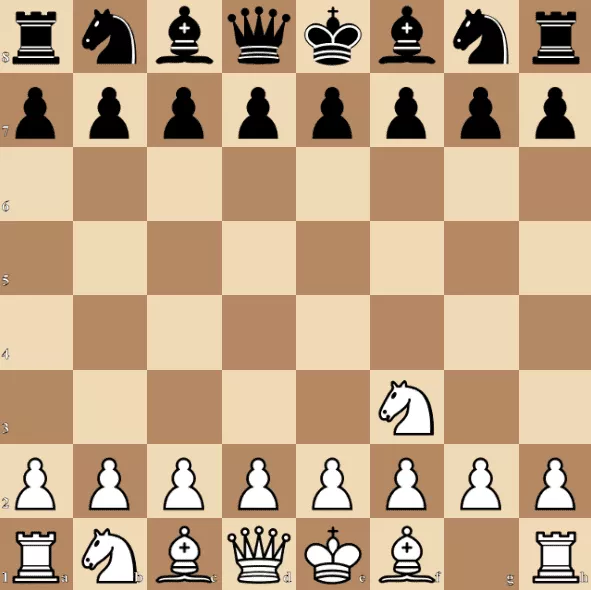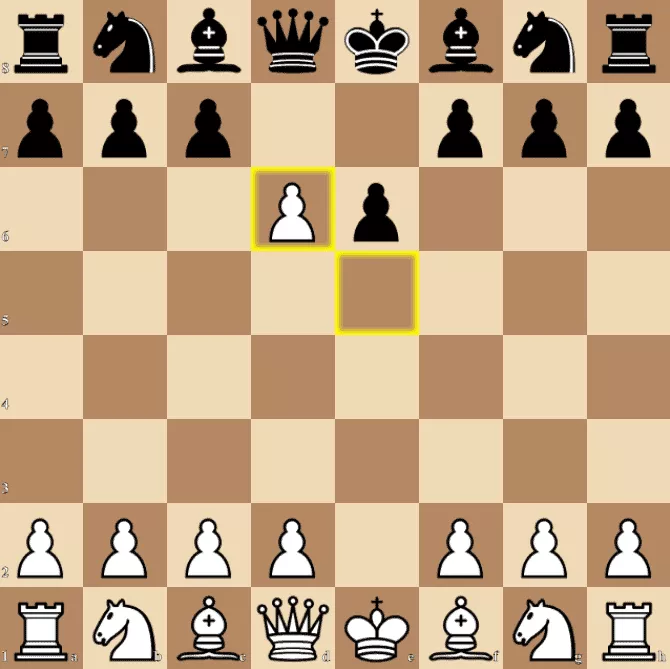|
|
Post by Whiterook on Apr 25, 2022 9:43:41 GMT -5
Algebraic notation is the standard way to describe chess moves. With algebraic notation, every square is a coordinate based on White’s perspective. The bottom left corner square is a1 (it’s a dark square if your chess board is facing the right way). The square above that is a2, and the square above that is a3, and so on. The square to the right of a1 (again, from White’s perspective) is b1, the square to the right of that is c1, and so on. This explanation makes it sound more complicated than it is though – a picture is worth 1,000 words!  In chess terminology: - Each of the rows (the number part of the coordinate) is called a rank. The files are named with their number.
- Each of the columns (the letter part of the coordinate) is called a file. The files are named with their letters.
The Major PiecesThe first thing you have to know is the name of the pieces in algebraic notation. The major pieces are: - K = King
- Q = Queen
- R = Rook
- N = Knight
- B = Bishop
These are the most powerful pieces in the game. So using the chessboard map outlined above, if I wanted to move White’s King-side Knight to square on column file f, row rank 3; it would be annotated “Nf3” (pronounced simply as “knight f3” or “knight to f3”).  More specifically, if it were White’s first move of the game, you would say 1.Nf3. If subsequently Black also moved their king’s knight out, say to f6, the first moves of the game would be written 1.Nf3 Nf6. If White followed that move by moving their second knight to c3, the whole game would be written as 1.Nf3 Nf6 2.Nc3. The Lowly PawnPawn moves are simply described as the square they move to. For example, moving your king’s pawn two squares up would simply be written as e4, and chess players universally understand this as a pawn move, because no letters precede the square notation. It would look like this, from White's perspective…  The beauty of algebraic chess notation is, it’s absolute! Meaning, it’s the exact same square from Black’s perspective (the trick being, to think of the rank and files designation upside down!)…  |
|
|
|
Post by Whiterook on Apr 25, 2022 10:21:00 GMT -5
CastlingCastling is the special move done only once in a game, if it’s done at all, and can really save your King's bacon! It can be done two ways: 1. The most common way used is by moving your King to the two spaces to the right (kingside), with the Rook shifting to the square to the King’s left. In order to perform this maneuver, both that side’s Bishop and Knight would have needed to vacate their home squares to allow the passage swap of King and Rook. This is called a “Kingside Castle”, as shown as below, and chess players would annotate it as O-O. You can read it as, and is pronounced “castles kingside.”  2. The opposite side can be chosen instead (given the circumstances in pending assault by your opponent) and is achieved by moving your King three squares to the left (queenside), with the Rook shifting to the square to the King’s right. Again, in order to perform this maneuver, both that side’s Bishop and Knight would have needed to vacate their home squares to allow the passage swap of King and Rook. In the case of “Queenside Castling”, chess players write O-O-O. You can read it as, and is pronounced “castles queensideside.”
|
|
|
|
Post by Whiterook on Apr 25, 2022 10:29:25 GMT -5
The CaptureWhen a piece is captured, we write an x before the square. For example, let’s say you want to capture the Black Knight in the center of the board using your Knight on f3, as in the diagram below. How would you write this move in chess notation?  The answer is Nxd4 (pronounced “knight takes d4”). Notice that you don’t mention it’s a knight that you’re capturing on that square – you just say you’re capturing the square. If your opponent’s piece were a bishop, the move would still be Nxd4. Pawn, queen, rook, you name it – it’s still Nxd4.
|
|
|
|
Post by Whiterook on Apr 25, 2022 10:46:40 GMT -5
En passantOne type of capture you have to be careful with is the en passant capture. If your pawn is one square into the enemy’s half of the board (as shown in Illustration 1 below, the White pawn on e5), and your opponent advances a pawn two squares such that it lands next to it (the Black pawn, also shown in Illustration 1, in d5)… 
Illustration 1…you can capture it en passant, like so…  Illustration 2 Illustration 2In this case, you would write the capture as “dxe6”, even though the pawn you captured was on d5. That’s because you are showing where your pawn ended up. In other words, even though Black’s pawn was moved initially, two spaces to d6, your White pawn subsequently snagged and bagged him before he ever made it there!
|
|
|
|
Post by Whiterook on Apr 25, 2022 11:01:28 GMT -5
CheckTo describe a check, simply write + after the move. Imagine you want to move your Rook from b2 to b7in (straight up to the 7th rank ) to deliver a check to the enemy Black King. How would you annotate that in chess notation?  The answer is “Rb7+” (pronounced “rook b7 check” or “rook to b7 check”). CheckmateIf the check you play results in checkmate, you change the + to a # (pronounced “checkmate” or “mate”). For example, Rb7# (but in the diagram above, Rb7+ is not checkmate!).
|
|
|
|
Post by Whiterook on Apr 25, 2022 11:16:42 GMT -5
Promotion
The final type of move you need to know in chess notation is the promotion of a pawn. As an example, say a White Pawn reaches the 8th rank (or a Black Pawn reaches the 1st rank), it can turn into any piece it wants (except for a king or another pawn).
To write this in algebraic notation, you would use an =. For example, if White’s a-pawn was promoted to a queen, you would write a8=Q. If you promote the pawn to a knight instead of a queen, you would write a8=N.
|
|
|
|
Post by Whiterook on Apr 25, 2022 11:28:43 GMT -5
2-Piece Possibilities Sometimes, the same type of piece can go to the same square – Some of the major pieces are in pairs (e.g., Rooks, Knights, and Bishops) and potentially both of them could make the same move. for example, take the White Rooks in a1 and f1… 
If White wanted to move the rook on f1 to e1, it would be confusing to write Re1, because the rook on a1 could also move to e1. So, to avoid this confusion, you would write “Rfe1” (i.e., “the rook on the f-file is the one going to e1). Similarly, if White wanted to move the f3 knight to d2, White would have to write “Nfd2.” But consider the Black rooks in the same position. Suppose Black wants to move the rook on c8 to c7. Well, in this case, both the rooks are on the c-file, so how would Black record that? The answer is “R8c7” (i.e., “the rook on the 8th rank is the one going to c7”).
|
|
|
|
Post by Whiterook on Apr 25, 2022 11:31:05 GMT -5
Chess Notation Cheat Sheet
For handy use, here is a simple cheat sheet you can refer which sums up everything above and gives some examples:
king = K queen = Q rook = R knight = N bishop = B
castles kingside = O-O castles queenside = O-O-O
takes = x check = + checkmate = #
Bxf3 “bishop takes f3”
Qe7+ “queen to e7 check”
Rb8# “rook b8 mate”
exf6 “e takes f6” (the e-pawn is capturing the pawn or piece on f6)
d8=Q (the d-pawn reached the 8th rank and turned into a queen)
Nbd2 (both knights could go to d2, but the knight that was on the b-file was the one that went to d2)
R8c2 (both rooks were on the c-file, but the rook that was on the 8th rank was the on that went to c2).
|
|














